29 March 2013
In response to great demand, we have decided to publish on our site the long and extraordinary interviews that appeared in the print magazine from 2009 to 2011. Forty gripping conversations with the protagonists of contemporary art, design and architecture. Once a week, an appointment not to be missed. A real treat. Today it’s Peter Eisenman’s turn.
Klat #04, fall 2010.
Peter Eisenman Architects won the competition to build the City of Culture of Galicia in 1999, beating other finalists such as OMA, Steven Holl, Manuel Gallego Jorreto, Ricardo Bofill, Jean Nouvel and Daniel Libeskind. The controversial project has encountered delays due to technological complexities, cost overruns and changes of government. The first two buildings, a library and an archive, have been completed and will be opened to the public at the end of 2010. The rest of the buildings will follow at a later date. I interviewed Eisenman last May, at the Hostal de los Reyes Católicos in Santiago de Compostela, and asked him to explain better the identity and function of the Cidade.
I can’t help noticing that you give a lot of interviews…
Yes, but they are all on different subjects… In addition to my work as an architect I write, I lecture, I teach, so I end up giving interviews about everything, from football to theory. Perhaps the least interesting topic for me is architecture. Architecture is basically boring as an interview subject.
Indeed, you’ve been interviewed quite a bit on the subject of politics.
That’s because many of my clients are to the right-of-center politically, so interviewers occasionally try to get me to say right-oriented things…
Well, I hate to disappoint you, but most of my questions have to do with architecture; specifically the City of Culture of Galicia. Is this the most important project of your career?
Now, the City of Culture is not boring, I am very excited by the buildings. It is certainly one of my most important projects.
It’s currently the largest construction site in Spain, if I’m not mistaken, and probably one of the largest in Europe.
It’s a million and a half square feet under cover, which makes it larger than the Getty Center. So yes, it’s a very large project.
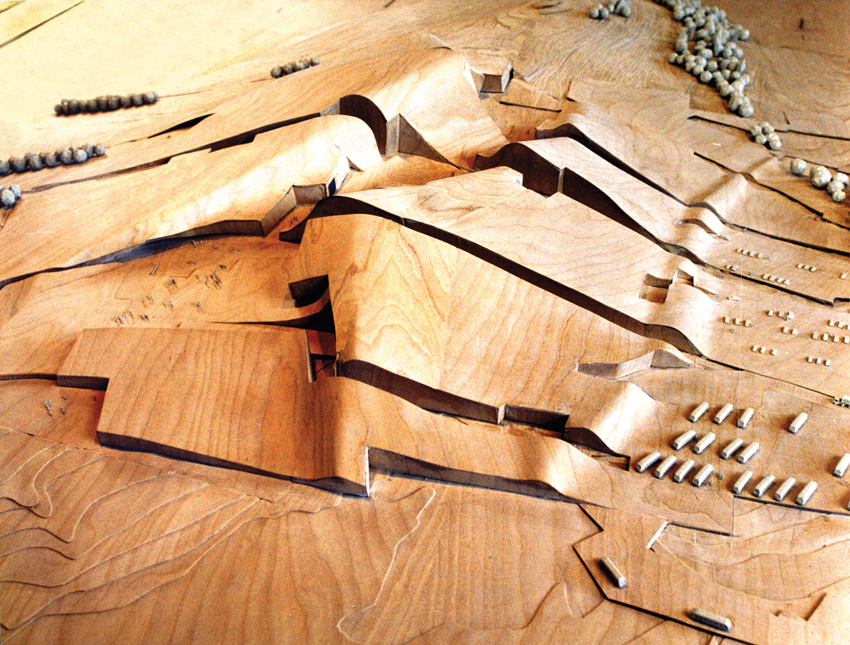
Eisenman Architects, City of Culture of Galicia, Santiago de Compostela, 1999-ongoing. Competition model
Does building in Spain differ very much from building in the USA or Germany?
All countries have different aspects. Take Europe and America. There is much more concern in Europe for public space than there is in the United States. In the US, public space is mainly controlled by developers. You could not do a public project of this scale on public land in the United States, it would be taken up by developers. In Germany, the Holocaust Memorial sits on a prime piece of real estate in the center of Berlin. This would be impossible in New York, because of real-estate speculation. Europeans’ concern for public space manifests itself in the media. Every time I visit Spain, Germany or Italy there are requests for interviews with the press and television. Architecture is good media in Europe because cities are an important part of European culture. Galicia is different, though, because there is a certain longing for a return to the regional language and customs, there’s a certain “not wanting to be in the world.” Manuel Fraga is a very cultured and sophisticated man who, when president of Galicia, really wanted to do something good for Galicia. He didn’t want to do what Franco did at el Valle de los Caídos. He wanted to contribute to the culture of the territory, or even create a culture for the territory. When he was Spain’s Minister of Information and Tourism he created the Paradores, and as Galicia’s president he had the idea for the City of Culture architectural competition. When we won, Fraga was insistent the project had to be built, and built well. He worked very hard to do it. In Germany too it was a struggle to build the Holocaust Memorial, but there was general agreement that it should be built. Nobody questioned that. The disagreements were regarding what it should mean, how it should look, etc. There was more of a political consensus in the German parliament. Spain’s politics are more polarized. The politics in Spain are different, and you feel that when you’re doing architecture here. Nobody has ever built a project of mine as well as these buildings are being built in Galicia. Yet we still find ourselves having to educate the people of Galicia about this project.
But isn’t that somewhat ironic, since there’s a strong landscape metaphor in the City of Culture? Landscape is something the regional culture here values very dearly, I would think. I wonder if you could comment about nature in architecture, because lately we’re seeing a lot of architects likening their projects to mountains, rivers, glaciers and crystals rather than to architecture per se.
Nature is never used as a metaphor in my work. Rather, the work is concerned with a very fundamental architectonic project. The philosophical background to the work is the metaphysical dialectic: the relationship between ground and object. Since 1978 my work has attempted to confound the relationship between ground and figure, so that figure becomes ground and ground becomes figure. That’s why it is so difficult to photograph these buildings: they’re not objects. They’re not “image buildings.” They are experiential buildings, actual buildings for people, not metaphors. The innate idea in the City of Culture is that it is a hillside that has erupted and heaved itself up from the Monte Gaiás, that it is a preexisting object.
Did you ever consider a roof that the public could walk on?
We initially wanted people to be able to go up on the roofs, but all of the apparatus that we would have had to install – railings, etc. – raised too many issues. Wherever the roofs go down to the ground we have to put in what’s called a “ha-ha” to stop climbers. We now have a double roof: a waterproof roof overlaid with a stone roof. The roofs are very clean because all of the vents, ducts and exhausts are inside a two-and-a-half-meter interstitial space. Also, the roof and the interior ceiling slopes are different. This difference is part of the idea of the ground being a series of layers.
Mountain climbers like to say that they do what they do “because it’s there.”
The museum roof would be one steep climb!
In your work, you often use grids: found, grilles trouvées, appropriated grids. In many ways, your architecture is generated through processes involving grids, archeological or ideal, that are reproduced, layered and traced. In your early work, Houses I to X, the grids organize the programmatic and functional aspects – or perhaps we should say anti-functional aspects. But in the City of Culture the functional distribution is relatively independent of the grids, which here have more to do with joining different materials together, most remarkably different kinds of stone. The architecture of the Cidade becomes, perhaps, more phenomenological and less conceptual: more haptic than intellectual. The tectonics of these buildings are really quite remarkable and I’m wondering if Galicia has changed you. Has it veered you from being a conceptualist to being a phenomenologist?
Your interpretation is fair, but I would disagree with the “either-or” dualism of your question. The grid is the mark of the straight line. It is the mark of man in nature, whether it is the Nazca lines in Peru or the ley lines followed by the druids that reached Santiago. You could argue that that line is not merely conceptual, but also phenomenological, in that it marks man as opposed to nature. One of the problems of my architecture in its earlier stages was that it purposely did not address the phenomenological and over-exaggerated the conceptual. Manfredo Tafuri wrote an important essay in Houses of Cards entitled The Meditations of Icarus. Icarus tried to look into the sun, and of course looking into the sun is like looking into the mind of God. Tafuri wrote that I was trying to look into the mind of God when what I needed to do was come down to earth and not fall to earth like Icarus. That was important advice for me. The Cannaregio project from 1978 represented a radical change in my work with its digging into the ground, which metaphorically, in Freudian or Jungian terms, is digging into the unconscious. Yes, here in Santiago I become more involved with the tactile and the phenomenological, if you like… The second issue that this project raises for me is that I never had a theory of the urban. My projects were always small-scale: hermetic exercises of the mind about architecture, mining in the mind of architecture, rather than seeing it in the context of its urbanity. James Stirling once said that American architects encountered difficulty with any scale larger than the house. I think Richard Meier’s Getty is one example of that: at a small scale it works, but when you get to the scale of the urban agglomeration it is just little buildings blown up into big ones. You find that in Richard’s museum in Barcelona. Richard is an exquisite craftsman, but his are little buildings becoming bigger. I was always aware of that and wanted to avoid that problem. With the City of Culture you realize that you are involved in the urban, you are involved in the next scale, and with the caminos, the void spaces between buildings. It is not possible to simply enlarge lines. This naturally involves material, different scales, spaces that are both for one thousand people and for two people. You can’t do that with lines alone, and so what I call “partial figures” come into the gridded structures. There are four grids in the City of Culture. There is the medieval street grid of Santiago, there is a Cartesian grid, there is a topographic grid, and there’s the topological grid, which, like the druidic ley lines, is made of lines of force, which here are contemporary lines of force. Thus the phenomenological – the material – is not oppositional but integrated. This project forced me to explore a level of behavior and materiality that I never had to face before, even in the Wexner Center or in Cincinnati. In the space of the Wexner you still fundamentally read “grid.” It changes slightly in Cincinnati, but this is the next level, so I would argue that if it comes off – history will judge whether it comes off or not – it will be to the extent that this is the most ambitious of the projects that I will have done and probably the most complex theoretically and phenomenologically. You might be right to say there is a tension in between the two, but I would like to think that the two are integrated.
There is a certain tendency out there to categorize architecture into either of-the-mind or of-the-body. In the same way you seek to confound figure and ground, you are perhaps also seeking to confound mind and body, then.
I think this is correct. It is one of the ambitions of the project.
You are very active as a theorist, writer and critic, and you are a strong proponent of what you call “critical” architecture. How is a building critical? And how is this reflected in the Cidade?
The first question is much easier to answer than the second question. Let’s take Jackson Pollock, or Jasper Johns, or Francis Bacon, anybody you want. To the untrained eye, Pollock’s work all looks the same. But to the trained eye there is a difference. Pollock is not just painting a scene by throwing paint around. There is an idea. All great work has an idea in it, whether you like it or not. You can say “I like this one better,” but there’s a difference between what I might like and a better painting. A better painting has what I consider to be a “critical matrix” inside it for judging it on its own terms, outside of what we like or dislike. All great art, great music, great literature has a critical matrix within it, one that confounds, perhaps, even the object of the work. I would argue the same thing holds for architecture. In my book Ten Canonical Buildings I write about what makes buildings canonical, what gives them a critical matrix. All of cultural history is based on a critical matrix. Now, why I say the second question is more difficult to answer is that it’s too early to know whether the critical discourse we’ve just been talking about – figure, ground, materiality, phenomenology, conceptuality, scale – works at the level of experience. For example: the Arizona Cardinals’ stadium. I love sitting in it, but it has no critical discourse. Everybody thinks it’s fabulous because the field goes in and out and the roof opens up, and I love watching it fill up with people, but ultimately it’s only a stadium. Another example is a housing project we are doing in Milan. Two hundred thousand square feet. A big condominium project. What’s the critical discourse? It’s not social housing, it’s not an urban project that informs the city: it’s just a big housing block. How often do architects get a chance to do projects that are critical? Ninety percent of what Zaha does or what Frank does or what Michael Graves does is not critical. Ninety percent of what I’ve done is not critical.
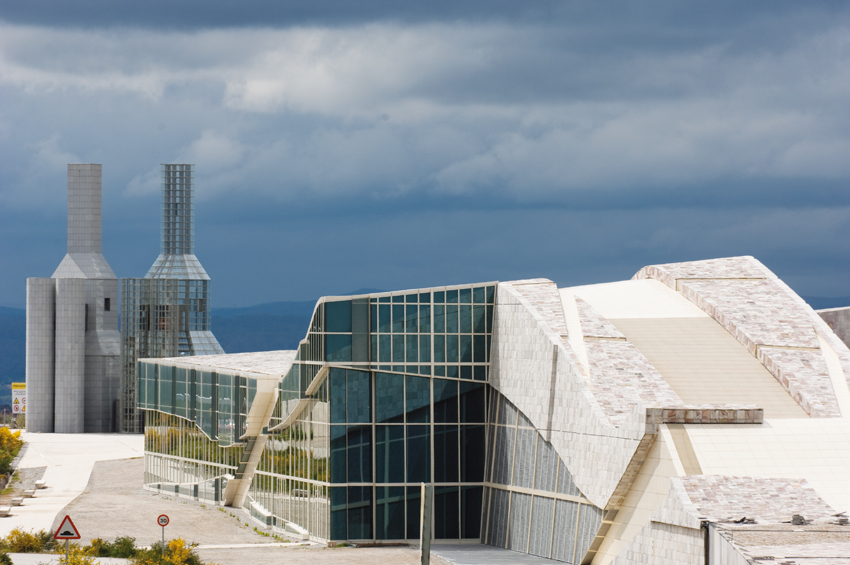
Eisenman Architects, City of Culture of Galicia, Santiago de Compostela, 1999–ongoing.
Hemeroteca (John Hejduk towers in the background). Courtesy: Foundation for the City of Culture of Galicia. Photo: Manuel G. Vicente
Interesting to hear that for you criticality has much more to do with canonical-discursive value rather than criticality in the sense of a political position against capitalism, for example, or the status quo…
No, no, there is little of that in my work. Criticality questions what is assumed to be the internal structure of any discourse.
The C word has been used in another sense by others whom you probably know…
I’m talking about criticality within the discipline, about innovation within the discipline, the canon. I wrote recently that any discipline is made up entirely of “states of exception,” that what inevitably defines a discipline is transformation from the norm.
You are one among a relatively small group of global architects, architects whose work is collected and discussed worldwide. But built architecture, no matter how global, is inextricably bound to its site, and the Cidade is exemplary in that regard. How local is the City of Culture, and how global is it? What’s the “mix”?
That brings up a really interesting question, the question of genius loci as a tradition.
Christian Norberg-Schulz.
Genius loci is an idea that digital communication and globalization have undermined. Learning from Las Vegas, a book about genius loci, would be impossible today because everything is Las Vegas, everything is a decorated shed. We used to be able to go to Hermès in Paris at the Faubourg Saint Honoré. This was a very special place. Now you can go to Hermès in eleven locations in Las Vegas alone. You used to be able to go to Venice. That was a special place. Now you can go to Venice in Las Vegas, you can go to Venice in Macau. Genius loci has become part of branding, advertising, media. Information systems now use what were once real places to make non-places. There is no longer any possibility in the world of the “end of the earth.” What we are doing in Galicia, on the one hand, is disturb its hermetic world, while on the other we are putting Galicia into the world. To carve out a magic mountain, using the very medieval street pattern that made it what it was when it was hermetic. We are trying to use those archaic hermetic metaphors to bring it into the twenty-first century. So there is a dialogue between genius loci, which is no longer possible, and branding à la Hermès. The City of Culture looks like what it was, only transformed. It doesn’t look medieval, but it has a medieval structure in it. It has a Cartesian grid, it uses local stone, but in a different way. This combination of things supports the idea that Galicia needs to be part of the world now. Our client wanted “a project that is in the world.” Not one of the other competition entries referred to anything of Galicia at all. Daniel Libeskind did what he does, Jean Nouvel did a beautiful bar building, Rem did a big circle, but there was nothing Galician about them. They could have been anywhere. They were just brands. What we tried to do is to take whatever the “Eisenman” brand is – which is not an image, but an idea – and bring it out of the Galician earth. We were really concerned about that. From the outset, we were told that what Galicia and Santiago didn’t want was another Bilbao. They wanted something to play against Bilbao, to bring people here, but not through an image building that would suck all the energy out of one place and put it into another place. Even though Bilbao created energy, it also sucked energy into its being. We did exactly the reverse. I think we won this building competition because we did a non-building.
But unlike Bilbao, Santiago has been a tourist town for centuries. Bilbao was a grungy industrial town, but Santiago is the third most important Christian pilgrimage destination after Jerusalem and Rome. People have been traveling here religiously in order to see a miraculous icon for centuries.
The leadership here is very conscious of the fact that we live in a secular world today, and believes that it is time to bring the secular and the sacred together in Galicia. The idea behind the choice of the Monte Gaiás site is that the pilgrimage route would go over it before descending into town: a passage through the secular to reach the sacred. That was the idea. They realized that Galicia could not enter the modern world without secular culture. The City of Culture will not conflict with the cathedral, but it will attract additional visitors who come for the architecture, just as they come to Bilbao.
So the idea for the City of Culture was to diversify Galicia’s tourist industry?
Which is not a bad idea. Spain needs to diversify all of its industry.
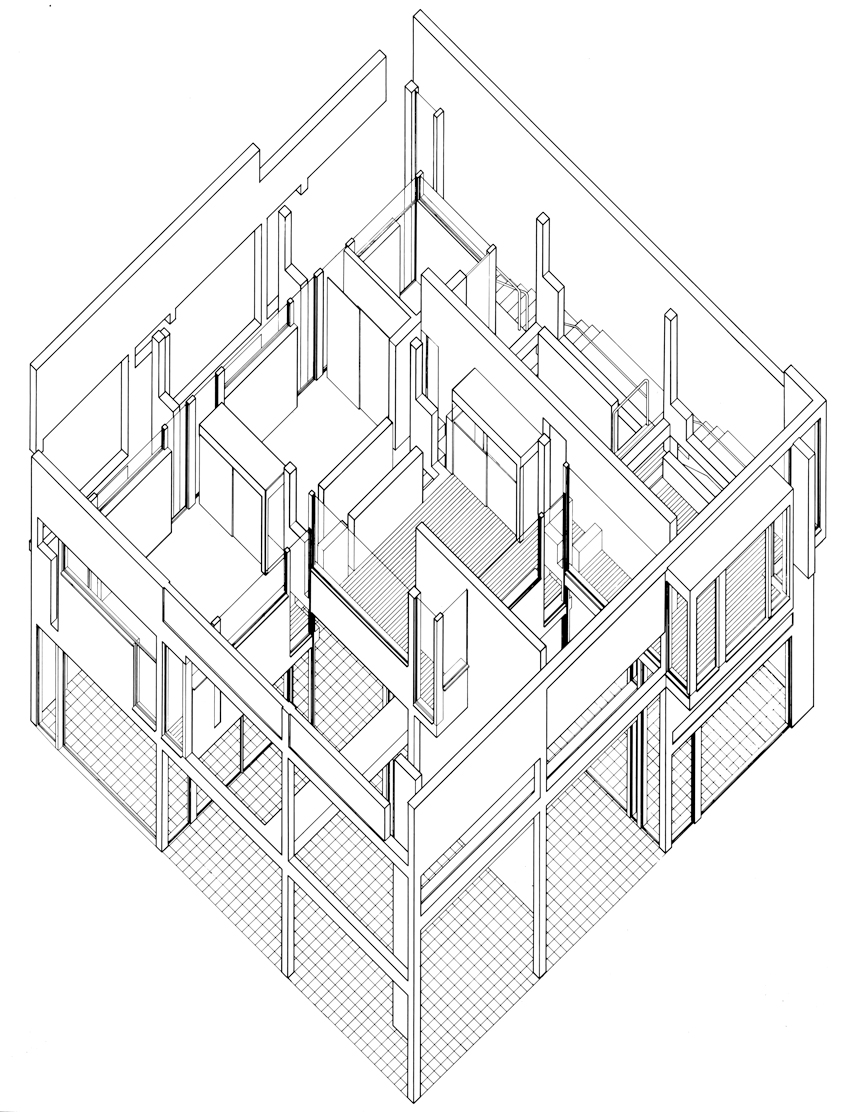
Peter Eisenman, House II, Hardwick, Vermont, 1969-1970. Disegno assonometrico/Axonometric drawing. Courtesy: Eisenman Architects
I would like to bring up the relationship between what we might call an “auteur architecture”, such as yours, to an “anonymous building” industry that is formulaic and purely economically driven. Along the roads leading into Santiago there’s a lot of recent building construction – let’s not call it architecture – that leaves a great deal to be desired. Spain is actually quite notorious for having on the one hand very high-quality new public buildings and public spaces, but on the other hand horrendous, kitschy, shoddily built private-sector construction. The real-estate bubble here was one of the biggest in the world, perhaps coming only after Dubai’s. Real-estate speculation became, next to tourism, one of the big “motors” of the economy here. I can’t help but wonder if high-profile auteur architecture isn’t motivated – and this gets back to the religious metaphor – as some sort of atonement for the sins of speculation. Have you ever wondered if that’s not perhaps one of the purposes of these kinds of projects: to compensate for all the crap that’s out there?
The answer is no. The auteur filmmaker was reacting to the commercialism of Hollywood cinema. Godard had a project, Antonioni had a project, Bresson had a project. I would say that all great architects, despite what they’re reacting to, have a project. Since I wrote my PhD dissertation in Cambridge I have been developing a project, but it has never been in contradistinction to developers, because I’ve worked for developers and speculators. I don’t think there’s any thought in my mind that an auteur project, and especially my project, has anything to do with atonement. One could argue that the Holocaust Memorial in Berlin is about atonement, but I don’t think it has anything to do with that. What I wanted to do in Berlin was not so much give history back to the Germans as to give them their memory back, because the Holocaust history has been driven by Israel, Americans and things like Schindler’s List. I would like to think that the City of Culture gives Galicia a part of the history of today, of contemporary Spain. Not to give it back its history – it’s always lived in its history – but to bring its history into contemporary Spain.
One of the things about film, and especially auteur film, is that it enjoys a high degree of autonomy…
One of my favorite words…
A concept that is somewhat more problematic when it comes to architecture.
You say that but I don’t think so. What I mean by critical has nothing to do with the political, it has to do with the nature of the discipline of architecture. If I do a public housing scheme, I can solve a political problem, a social problem, an environmental problem and an ecological problem, but as an architect I also have the responsibility to solve an architectural problem. All buildings don’t need to do that and all films don’t need to be auteur either, so I would argue we don’t have to worry about bad building or anonymous building. Ninety-nine percent of it is going to be that anyway. Ninety-nine percent of all books is not literature. If you go into a bookstore in an airport you won’t find one piece of literature because nobody wants to read literature while they are traveling. Two Eisenman buildings on one campus may be one too many, but one Eisenman as a cultural gesture is important, as is a Gehry or a Koolhaas…
As a certain “state of exception” you mentioned earlier…
One cannot worry about the ordinary, because the ordinary will take care of itself. My work is about the states of exception. I think it is important that the City of Culture not only function – you’re going to hear music in it, it’s going to have a library and an archive – but that it also be architectural. Why shouldn’t its architecture also nourish people?
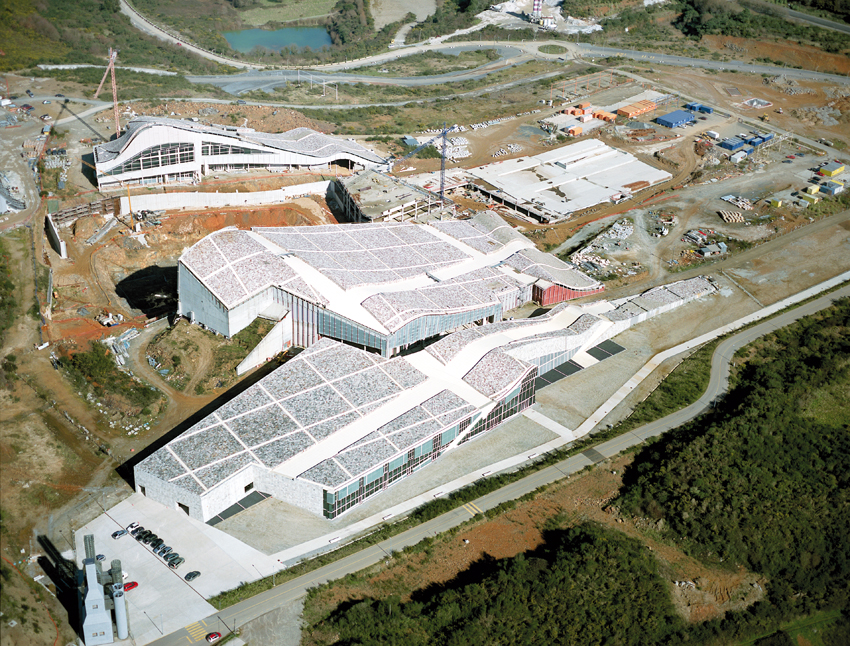
Eisenman Architects, City of Culture of Galicia, Santiago de Compostela, 1999-ongoing. Hemeroteca and Biblioteca (aerial view), 2009. Courtesy: Foundation for the City of Culture of Galicia. Photo: Manuel G. Vicente
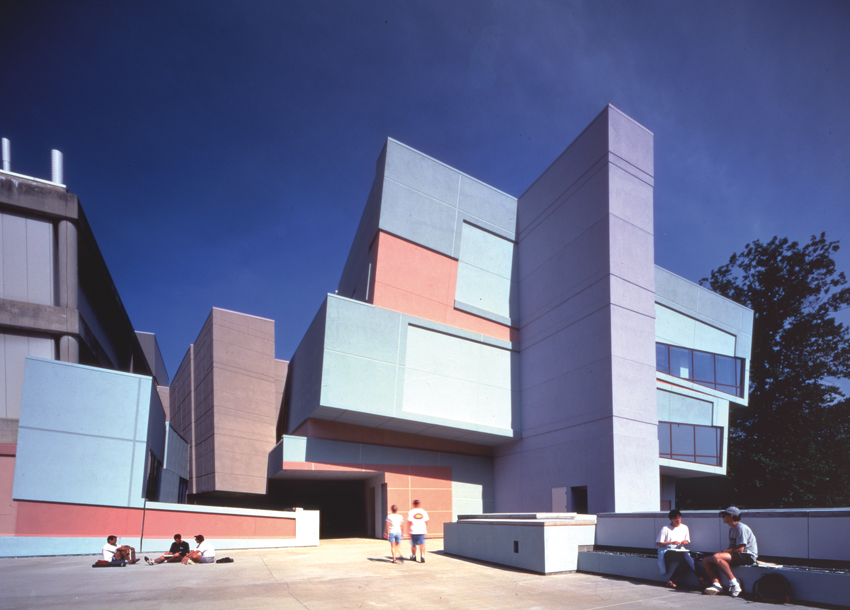
Eisenman Architects, Aronoff Center for Art and Design, University of Cincinnati, 1988-1996. Photo: Jeff Goldberg/Esto
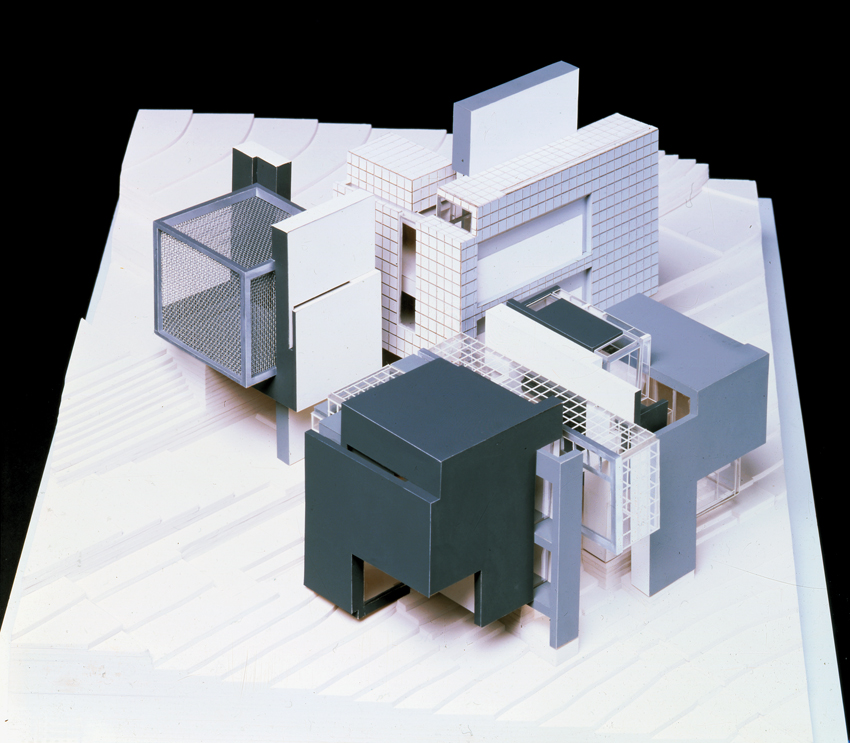
Peter Eisenman, House X, Bloomfield Hills, Michigan, 1975. Axonometric model. Photo: Dick Frank Studio. Courtesy: Eisenman Architects